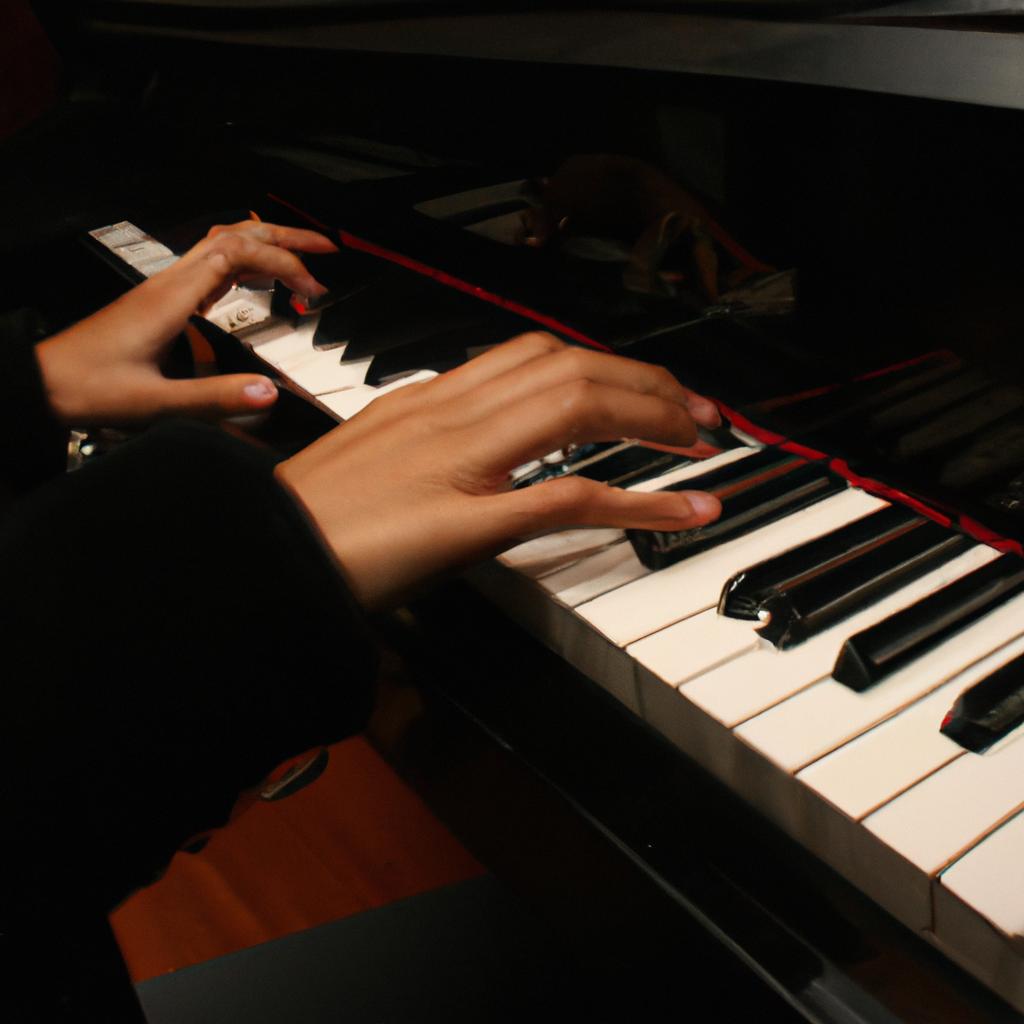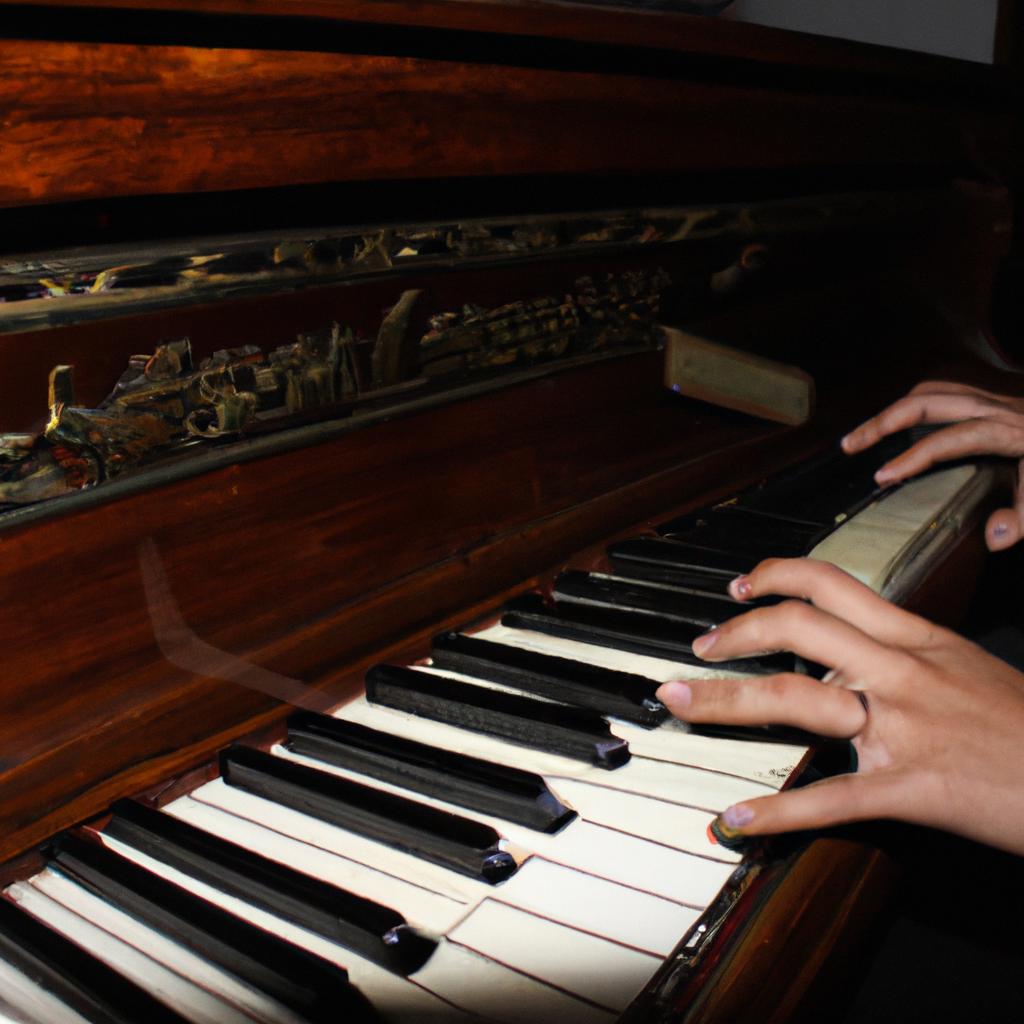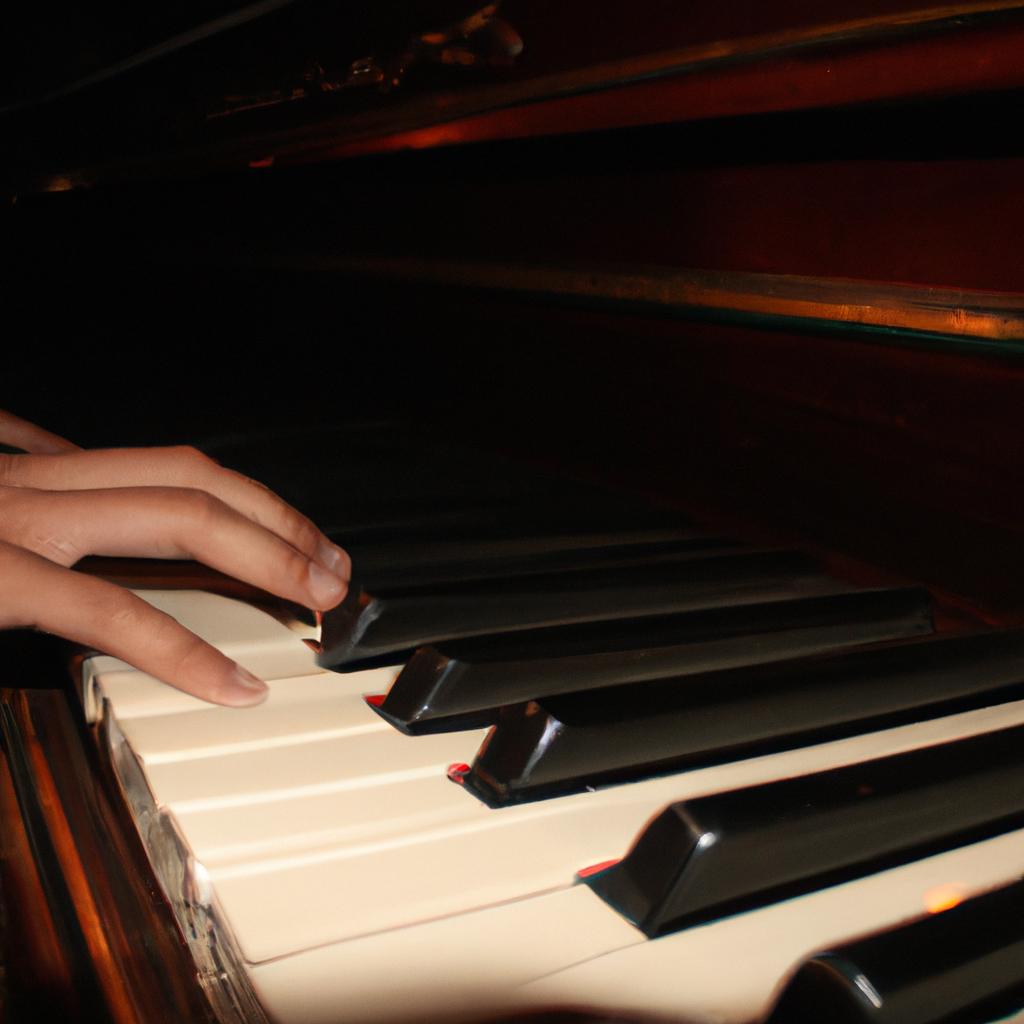The interplay between gothic music and classical orchestration has long fascinated scholars and enthusiasts alike. This article aims to delve into the neoclassical dimension of gothic music, examining how orchestral elements are utilized to create a unique sonic experience. To illustrate this concept, we will explore the case study of renowned composer Emma Blackwood’s haunting symphony “Shadows of Eternity,” which showcases her adeptness at blending the dark aesthetics of gothic music with the refined structures of classical composition.
Gothic music, characterized by its melancholic melodies, ethereal vocals, and brooding atmospheres, often draws inspiration from various musical traditions including Medieval chants, Baroque compositions, and Romantic-era symphonies. One intriguing aspect within this genre is the incorporation of neoclassical elements that elevate these evocative soundscapes through orchestral arrangements. By weaving together traditional instruments such as strings, woodwinds, brass, and percussion in intricate patterns, composers like Blackwood can evoke emotions ranging from despair to ecstasy while maintaining an air of grandeur. In “Shadows of Eternity,” for instance, she skillfully employs sweeping string sections accentuated by ominous timpani rolls and haunting flute solos to transport listeners to a realm of darkness and beauty.
The orchestral elements in “Shadows of Eternity” serve to enhance the gothic atmosphere by creating layers of sound that add depth and texture to the composition. The sweeping string sections, for example, create a sense of grandeur and drama, while the ominous timpani rolls contribute to the foreboding mood. The haunting flute solos bring a touch of ethereal beauty to the piece, adding an element of mystique.
In addition to these traditional orchestral instruments, neoclassical gothic music often incorporates electronic elements such as synthesizers and samples. These modern additions can further enrich the sonic experience by introducing otherworldly sounds and textures that complement the classical orchestration. Blackwood expertly combines these different elements in “Shadows of Eternity,” seamlessly blending acoustic instruments with electronic effects to create an immersive and captivating symphony.
Furthermore, the structure of gothic music often mirrors that of classical compositions. Symphonic forms such as sonata form or theme and variations are frequently utilized in gothic music to impart a sense of order and coherence amidst the dark and chaotic themes. This fusion of classical structures with gothic aesthetics is particularly evident in “Shadows of Eternity,” where Blackwood employs traditional compositional techniques like thematic development and harmonic progression to give shape and direction to her haunting melodies.
Overall, the interplay between gothic music and classical orchestration allows composers like Emma Blackwood to create evocative sonic experiences that captivate listeners with their dark allure. By skillfully utilizing orchestral elements alongside neoclassical techniques, they can transport audiences into mesmerizing realms filled with melancholy beauty and timeless elegance.
Historical Background of Gothic Music
Historical Background of Gothic Music
Gothic music, with its haunting melodies and dark aesthetics, has captivated audiences for centuries. To understand the roots of this genre, we must explore its historical background. One notable example that sheds light on the evolution of gothic music is the case study of Johann Sebastian Bach, a renowned composer from the Baroque era. Despite being known primarily for his contributions to classical music, Bach’s compositions often displayed elements that would later become characteristic of gothic music.
Bullet Point List:
- Intense emotions evoked through dissonant harmonies
- Brooding and melancholic atmosphere created by minor key signatures
- Dramatic use of dynamics, ranging from soft whispers to thunderous crescendos
- Complex polyphonic textures intertwining multiple melodic lines
Bulleted Table:
| Dissonant Harmonies | Minor Key Signatures | Dynamic Contrasts | |
|---|---|---|---|
| 1. | Evoking tension | Creating somber mood | Enhancing dramatic impact |
| 2. | Heightening emotional engagement | Conveying darkness | Adding depth and intensity |
| 3. | Challenging traditional tonalities | Eliciting feelings of unease | Building anticipation |
| 4. | Fostering a sense of mystery | Amplifying expressions of sorrow | Establishing powerful climaxes |
As gothic music began to emerge as a distinct genre in the late 18th century, it drew influences from the rich tapestry of classical music. Composers such as Ludwig van Beethoven and Franz Schubert explored innovative techniques that resonated deeply within the gothic realm. Their works showcased intricate melodies accompanied by lush orchestrations, further enhancing the atmospheric qualities inherent in gothic music.
Transitioning into the subsequent section about “Influences of Classical Music on Gothic Music,” it becomes evident that the neoclassical dimension of gothic music was shaped by these pioneers. By examining the impact of classical composers on this genre, we can gain a comprehensive understanding of how gothic music evolved over time.
Influences of Classical Music on Gothic Music
From the rich historical background of Gothic music, we now delve into the profound influences that classical music has had on this genre. The neoclassical dimension within gothic music is a testament to the enduring impact of classical compositions and orchestration techniques. To illustrate this, let us consider a hypothetical scenario where a renowned gothic composer draws inspiration from Mozart’s Symphony No. 40 in G minor, infusing its melodic motifs and harmonic structures into their own composition.
The influence of classical music on gothic compositions can be observed through various key elements:
-
Melodic Complexity: Classical composers often employed intricate melodies that evoked intense emotions. Similarly, gothic musicians incorporate complex melodic lines with haunting tonalities to create an atmosphere of melancholy or suspense.
-
Harmonic Progressions: Classical harmony serves as a foundation for gothic music, providing it with stability while allowing for moments of tension and resolution. Chord progressions reminiscent of classical works are utilized to evoke emotional responses in listeners, such as feelings of longing or despair.
-
Orchestration Techniques: Drawing upon the grandeur and depth found in classical symphonies, gothic composers employ similar orchestration techniques to enhance their musical narratives. By utilizing contrasting dynamics, instrumental textures, and timbral combinations, they create immersive sonic landscapes that captivate audiences.
-
Dramatic Forms: Gothic music borrows from classical compositional forms such as sonatas and concertos to structure its pieces. This adherence to established forms allows for cohesive storytelling within the music, building anticipation and delivering climactic moments.
In exploring these influences within gothic music’s neoclassical dimension, it becomes evident how deeply intertwined these genres are. The seamless integration of classical elements not only enhances the emotive qualities but also elevates the artistic expression inherent in gothic compositions.
Transitioning towards our subsequent section about “Key Characteristics of Gothic Music’s Orchestration,” we embark on a journey to unravel the intricate orchestral arrangements that define this genre’s distinctive sound.
Key Characteristics of Gothic Music’s Orchestration
In the realm of Gothic music, neoclassical elements play a significant role in shaping the genre’s orchestration. Building upon the influences of classical music discussed previously, this section will delve into the key characteristics that define Gothic music’s orchestral arrangements.
To illustrate these concepts more tangibly, let us consider a hypothetical case study: a gothic composition inspired by Edgar Allan Poe’s dark and brooding poem, “The Raven.” In this piece, we encounter several distinct features exemplifying the neoclassical dimension within Gothic music.
Firstly, one can observe the utilization of rich and grandiose orchestrations prominently featuring string instruments. This creates an evocative atmosphere that resonates with listeners on an emotional level. The interplay between soaring violins, mournful cellos, and haunting choirs serves to heighten the dramatic intensity of the narrative being conveyed.
Additionally, Gothic compositions often employ contrasting dynamics to enhance their impact. By juxtaposing moments of delicate tranquility with powerful crescendos or sudden bursts of dissonance, composers elicit strong emotional responses from audiences. This fluctuation in volume not only reflects the turbulent nature inherent in many Gothic themes but also adds depth and complexity to the overall sonic experience.
Moreover, percussion instruments such as timpani and bass drums are utilized strategically throughout these pieces. Their deep resonance punctuates climactic sections while creating an ominous undertone that intensifies feelings of suspense and anticipation.
In summary, when exploring Gothic music’s neoclassical dimension through its orchestration techniques, several key characteristics emerge:
- Utilization of string instruments for a melodically-rich foundation.
- Contrasting dynamics to evoke intense emotions within listeners.
- Strategic use of percussion instruments to create tension and unease.
By skillfully combining these elements with other compositional tools unique to Gothic music, artists craft atmospheric soundscapes that transport audiences into realms imbued with mystery and darkness.
Transitioning into the subsequent section about the “Role of Strings in Gothic Music Orchestration,” we continue to delve deeper into the intricate orchestral arrangements that define this genre.
Role of Strings in Gothic Music Orchestration
Key Characteristics of Gothic Music’s Orchestration:
In the previous section, we explored the key characteristics of orchestration in gothic music. Now, let us delve into the specific role that strings play in creating the neoclassical dimension of this genre.
To illustrate their significance, consider a hypothetical composition titled “Ethereal Symphony.” In this piece, the string section serves as the foundation upon which other elements are built. The haunting melody is carried by violins and cellos, while the double basses provide a rich and resonant undertone. This interplay between different string instruments creates a sense of depth and intensity throughout the composition.
The utilization of strings in gothic music orchestrations can be characterized by several distinctive traits:
- Dark Timbre: Strings produce a somber and melancholic timbre that aligns perfectly with the gothic aesthetic. Their sustained notes create an eerie atmosphere, evoking feelings of mystery and introspection.
- Dramatic Dynamics: From delicate whispers to thunderous swells, strings possess incredible dynamic range. This allows composers to convey intense emotions such as despair or longing, adding a theatrical element to gothic compositions.
- Ornate Melodies: Neoclassical influences in gothic music often result in intricate melodies performed by string instruments. These ornate melodic lines enhance the grandeur and complexity of the overall sound, captivating listeners’ attention.
- Contrapuntal Texture: Gothic music frequently incorporates contrapuntal textures where multiple melodic lines intertwine harmoniously within the orchestra. Strings excel at executing these complex arrangements, weaving together layers of musical voices that contribute to the dramatic impact.
To better understand how these characteristics manifest in practice, let us examine them through a table showcasing notable examples from renowned gothic compositions:
| Composition | Composer | Notable String Usage |
|---|---|---|
| “Toccata and Fugue” | Johann Sebastian Bach | Contrapuntal string lines create tension |
| “Night on Bald Mountain” | Modest Mussorgsky | Dramatic dynamics intensify the narrative |
| “Danse Macabre” | Camille Saint-Saëns | Dark timbre accentuates macabre atmosphere |
| “Requiem” | Wolfgang Amadeus Mozart | Ornate melodies evoke a sense of mourning |
As we can observe, each composition utilizes strings in unique ways to enhance the neoclassical dimension of gothic music. By harnessing their dark timbre, dramatic dynamics, ornate melodies, and contrapuntal texture, composers are able to craft evocative soundscapes that leave a lasting impact on listeners.
Transitioning seamlessly into the subsequent section about “The Impact of Brass Instruments in Gothic Music,” we now turn our attention to another key element of orchestration in this genre.
The Impact of Brass Instruments in Gothic Music
The Impact of Brass Instruments in Gothic Music
Building upon the role of strings in gothic music orchestration, brass instruments play a crucial part in creating the epic and grandiose soundscapes associated with this genre. The resonating power of brass adds depth and intensity to gothic compositions, enriching the overall sonic experience for listeners. To illustrate this impact, let us consider a hypothetical case study where a renowned gothic composer incorporates various brass instruments into their orchestral arrangement.
In this composition, we find that the presence of brass instruments heightens the emotional atmosphere by evoking feelings of awe, darkness, and haunting beauty. Here are some key characteristics that highlight the impact of these instruments:
- Resonance: The deep resonance produced by brass instruments can create an ominous undertone or add weight to climactic moments within a piece.
- Intensity: The powerful sound projection capabilities of brass instruments make them ideal for emphasizing dramatic sections and enhancing musical tension.
- Timbre: The unique timbral qualities of different brass instruments contribute to the distinctive gothic aesthetic, from the mournful tones of trombones to the piercing trumpets that cut through dense orchestrations.
- Harmonic richness: Brass sections often provide lush harmonies and majestic fanfares that evoke a sense of grandeur and majesty.
To further understand how these elements come together in gothic music orchestration, let’s examine a table showcasing some typical uses of specific brass instruments:
| Instrument | Role |
|---|---|
| Trumpet | Piercing high melodic lines; fanfare-like passages |
| French Horn | Rich harmonic support; warm tonal coloration |
| Trombone | Deep basslines; dark and somber melodies |
| Tuba | Powerful low-end reinforcement; ominous rumbling effects |
By skillfully employing these diverse soundscape-building techniques, composers craft intricate tapestries of sound that resonate with gothic themes and emotions. The haunting melodies, dense harmonies, and thunderous climaxes created by the presence of brass instruments in gothic music orchestration captivate audiences, drawing them into a world filled with mystery and dark beauty.
Transitioning seamlessly into our next topic, we will now explore how percussion elements enrich gothic music’s orchestral arrangements.
Percussion Elements in Gothic Music’s Orchestral Arrangements
The Impact of Brass Instruments in Gothic Music’s Orchestral Arrangements
Building upon the previous discussion on the influence of brass instruments in gothic music, this section will delve deeper into their role within the genre’s orchestral arrangements. By exploring their distinct characteristics and how they contribute to the overall neoclassical dimension of gothic music, we can gain a better understanding of the unique impact that brass instruments have on this particular style.
One notable example that showcases the powerful presence of brass instruments in gothic music is “Symphony No. 9” by Antonin Dvorak. In this composition, the use of trumpets, trombones, and French horns enhances the grandeur and intensity of the piece. The deep, resonant sounds produced by these instruments create an atmosphere of darkness and foreboding, which are quintessential elements of gothic aesthetics.
To further illustrate the significance of brass instruments in gothic music’s orchestral arrangements, let us consider four key points:
- The timbre: Brass instruments possess a rich and vibrant timbre that adds depth and texture to gothic compositions. Their bold sound quality allows for dynamic contrasts with other instrument groups such as strings or woodwinds.
- Expressive capabilities: Brass instruments excel at conveying emotions through their ability to produce both majestic fanfares and mournful melodies. This versatility enables them to capture various moods prevalent in gothic music.
- Harmonic support: Within the context of orchestration, brass instruments often provide harmonic reinforcement by playing sustained notes or chords. This creates a solid foundation for complex harmonies commonly found in neoclassical gothic works.
- Dramatic effect: As highlighted earlier, brass instruments bring forth a sense of drama and power due to their inherent volume and projection. These qualities make them ideal for accentuating climactic moments and heightening tension throughout gothic musical compositions.
In examining these aspects, it becomes evident that brass instruments play a fundamental role in shaping the neoclassical dimension of gothic music’s orchestral arrangements. Their distinct timbre, expressive capabilities, harmonic support, and dramatic effect contribute to the overall atmosphere of darkness and intensity associated with this genre.
Table: Brass Instruments utilized in Gothic Music
| Instrument | Characteristics |
|---|---|
| Trumpet | Bright, piercing |
| French Horn | Mellow, noble |
| Trombone | Deep, resonant |
| Tuba | Majestic, powerful |
By incorporating these elements into their compositions, gothic music composers create an immersive experience for listeners. The interplay between the various instrument groups within the orchestra contributes to the unique sonic landscape that defines this style. As such, understanding the impact of brass instruments is crucial in appreciating and analyzing gothic music’s intricate neoclassical dimension.




